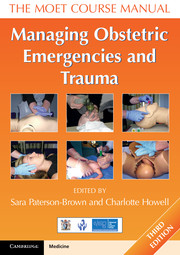Book contents
- Frontmatter
- Dedication
- Contents
- Working Group
- About the authors
- Acknowledgements
- Abbreviations
- Section 1 Introduction
- Section 2 Recognition
- Section 3 Resuscitation
- Section 4 Trauma
- Section 5 Other medical and surgical emergencies
- Section 6 Obstetric emergencies
- 24 Pre-eclampsia and eclampsia
- 25 Major obstetric haemorrhage
- 26 Caesarean section
- 27 Placenta accreta and retained placenta
- 28 Uterine inversion
- 29 Ruptured uterus
- 30 Ventouse and forceps delivery
- 31 Shoulder dystocia
- 32 Umbilical cord prolapse
- 33 Face presentation
- 34 Breech delivery and external cephalic version
- 35 Twin pregnancy
- 36 Complex perineal and anal sphincter trauma
- 37 Symphysiotomy and destructive procedures
- 38 Anaesthetic complications in obstetrics
- Section 7 Triage and transfer
- Section 8 Human issues
- Index
30 - Ventouse and forceps delivery
- Frontmatter
- Dedication
- Contents
- Working Group
- About the authors
- Acknowledgements
- Abbreviations
- Section 1 Introduction
- Section 2 Recognition
- Section 3 Resuscitation
- Section 4 Trauma
- Section 5 Other medical and surgical emergencies
- Section 6 Obstetric emergencies
- 24 Pre-eclampsia and eclampsia
- 25 Major obstetric haemorrhage
- 26 Caesarean section
- 27 Placenta accreta and retained placenta
- 28 Uterine inversion
- 29 Ruptured uterus
- 30 Ventouse and forceps delivery
- 31 Shoulder dystocia
- 32 Umbilical cord prolapse
- 33 Face presentation
- 34 Breech delivery and external cephalic version
- 35 Twin pregnancy
- 36 Complex perineal and anal sphincter trauma
- 37 Symphysiotomy and destructive procedures
- 38 Anaesthetic complications in obstetrics
- Section 7 Triage and transfer
- Section 8 Human issues
- Index
Summary
Objectives
On successfully completing this topic, you will be able to:
decide when an instrumental delivery is appropriate
decide which instrument is most appropriate in a specific circumstance
appreciate the techniques required for vacuum and forceps delivery
recognise and appreciate the causes of failure to deliver with the instrument selected
know what to do when the instrumental delivery has failed.
Introduction
Operative vaginal delivery (OVD) aims to expedite the delivery of a baby who is believed to be at risk of compromise or when the mother is unable to push it out herself. Worldwide, assisted vaginal delivery remains an integral part of the obstetrician's duties. Rates vary from 1.5% of deliveries (Czech Republic) to 15% (Australia and Canada) and from 9% to 13% regionally in the UK. These varying rates reflect not only different clinical practices but also different attitudes. Low OVD rates may reflect high CS rates, including those performed at full dilatation, because of a reluctance to perform instrumental deliveries. There is evidence of an increasing trend towards using emergency CS directly for delay in the second stage, without resort to a trial of instrumental delivery. This is particularly with occipito-posterior positions at midcavity. Although instrumental vaginal delivery can be hazardous and should be undertaken with care, the difficulty of CS at full dilatation should not be underestimated; it can be extremely difficult and is associated with high maternal morbidity. There is emerging evidence to support the direct supervision of trainees in this situation in order to maximise the appropriate number of operative vaginal deliveries both attempted and achieved.
Women who labour are, by definition, aiming for vaginal delivery and therefore efforts should be focused on helping them to achieve this normally and safely. Various techniques may help in achieving high spontaneous vaginal delivery rates, such as the use of a partogram, companionship in labour, delaying pushing in women who have had epidural anaesthesia, upright posture and active management of the second stage of labour using oxytocin in nulliparae with epidurals.
- Type
- Chapter
- Information
- Managing Obstetric Emergencies and TraumaThe MOET Course Manual, pp. 347 - 368Publisher: Cambridge University PressPrint publication year: 2014

